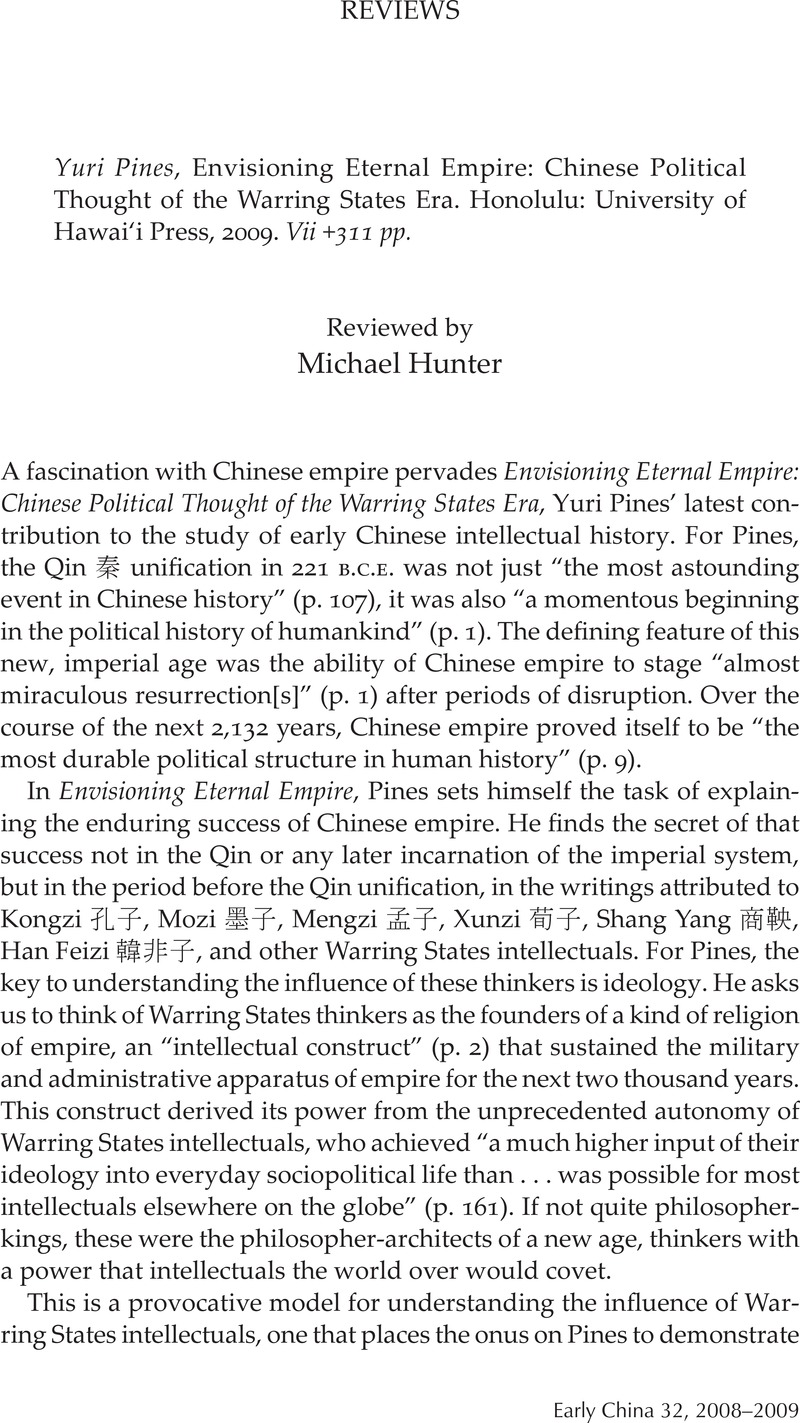No CrossRef data available.
Published online by Cambridge University Press: 08 August 2014

1. See Zehua's, LiuZhongguo de wangquanzhuyi 中國的王權主義 (Shanghai: Renmin, 2000)Google Scholar.
2. University of Hawai'i Press, 2002.
3. See Hsu's, Ancient China in Transition (Stanford: Stanford University Press, 1965), 34–52, 86–106Google Scholar, and Falkenhausen's, “Social Ranking in Chu Tombs: The Mortuary Back-ground of the Warring States Manuscript Finds,” Monumenta Serica 51 (2003): 439–526CrossRefGoogle Scholar.
4. For She's, Chen biography, see Shi ji 48.1949–65Google Scholar.
5. The works of Zehua, Liu, particularly Xian-Qin shiren yu shehui 先秦士人與社會 (Tianjin: Tianjin renmin, 2004)Google Scholar and Zhongguo de wangquanzhuyi, receive the most attention. None of the other scholars are cited more than once or twice.
6. For a complete list of the various types of shi one finds mentioned in pre-Qin texts, see Zehua's, LiuXian-Qin shiren yu shehui, pp. 1–14Google Scholar.
7. For examples of these polemics, see the Mengzi's statement at 3B/9 that followers of Mozi and Yangzi 楊子 are no better than “beasts” (shi qinshou ye 是禽獸也); the Mozi's “Against the Ru” (“Fei ru” 非儒) chapter; the Xunzi's “Against the Twelve Masters” (“Fei shi er zi” 非十二子) chapter; and the Han Feizi's critique of the ru and Mohists in “Five Vermin” (“Wu du” 五蠹) and “Flaunting Learning” (“Xian xue” 顯學).
8. For the (adapted) translation and source text, see Knoblock, John and Riegel, Jeffrey, The Annals of Lü Buwei: A Complete Translation and Study (Stanford University Press, 2000), p. 353 (section 15/4.2)Google Scholar. Here I do not adopt their translation of shi 士 as “scholar-knight.”
9. Translation adapted from Knoblock and Riegel, p. 401 (16/8.2).
10. Knoblock and Riegel, p. 402 (16/8.3).
11. Mengzi 7A/33.
12. Stevenson, Charles Leslie, a student of Wittgenstein, refers to such concepts as “persuasive definitions.” See his “Persuasive Definitions,” Mind 47 (1938): 331–50CrossRefGoogle Scholar.
13. http://plato.stanford.edu/. Elsewhere (242n38), Pines mentions Edward Slingerland as having ignored the political context of the concept of wuwei 無為 in his Effortless Action: Wu-wei as Conceptual Metaphor and Spiritual Ideal in Early China (Oxford: Oxford University Press, 2003)Google Scholar.
14. Paul Goldin's invaluable “Ancient Chinese Civilization: Bibliography of Materials in Western Languages” (available at http://www.paulrgoldin.com/) includes a number of recent works from the last ten years that, judging from their titles, have something to do with the “political” sphere of pre-imperial and early imperial China. In addition, the 1999 Cambridge History of Ancient China, ed. Loewe, Michael and Shaughnessy, Edward (Cambridge: Cambridge University Press)Google Scholar, contains a chapter by Mark Lewis, Edward entitled “Warring States: Political History” (pp. 587–645)Google Scholar that includes references to many of the sources Pines cites in Envisioning Eternal Empire.
15. On the difficulties involved in contextualizing manuscript collections found in tombs, see Giele, Enno, “Using Early Chinese Manuscripts,” Monumenta Serica 51(2003): 409–38, especially pp. 428–31CrossRefGoogle Scholar.
16. The full quotation reads as follows: “It is worth noting that this inscription was not a piece of shi propaganda, but was cast on a vessel placed in the king's tomb, where its message was directed at the king's ancestors, not the general public. If this is so, the inscription may well reflect the king's genuine sentiments.”
17. For an example of such an approach, see Schaberg, David, “Playing at Critique: Indirect Remonstrance and the Formation of Shi Identity,” in Text and Ritual in Early China, ed. Kern, Martin (University of Washington Press, 2005), 194–225, and especially his conclusion on p. 218Google Scholar.
18. My own preference is to treat anecdotes about Warring States political figures much as one would treat stories about gods and heroes in an ancient Greek context, i.e., as the raw narrative materials through which ancient authors explored topics and themes of general social, political, or philosophical relevance. Such stories probably contain kernels of historical truth (e.g., King So-and-So really did start a war with King Such-and-Such), but I suspect that contemporary audiences in both ancient China and ancient Greece were sophisticated enough to understand that historical accuracy was not the point of these stories.
19. Han shu 99A.4041–42. For the translation, see Dubs, Homer, The History of the Former Han Dynasty (Baltimore: Waverly Press, 1955), 3.130–31Google Scholar.
20. For the evidence that Liu Xiang compiled the received version of the Xunzi out of a collection of 322 pian 篇 of material, see Early Chinese Texts: A Bibliographical Guide, ed. Loewe, Michael (Berkeley: The Society for the Study of Early China, 1993), p. 178Google Scholar.
21. See Han shu “Yiwen zhi” 藝文志 entry on the Lun yu, 30.1717.